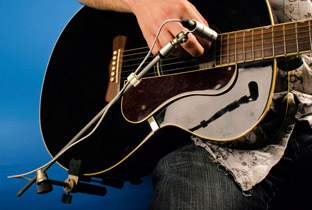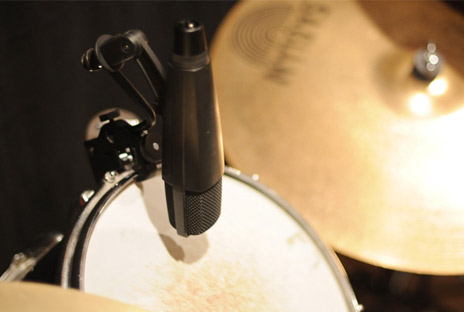Published
Tue, May 24, 2011, 13:00
- Step away from that sample library—this week we get excited about the art of recording instruments.

The vast array of sample libraries that have become available to producers in recent years is staggering. Think of almost any single instrument or ensemble group you can, and you'll find there's a matching library of well-recorded sounds waiting to be added to your tracks. Suddenly, we can all add children's choirs, frame drums, prepared pianos and other niche instruments, as well as more common ensembles such as strings and brass.
The only downside is that the art of engineering—the process of actually recording instruments and vocals—has suffered, as it's no longer the only way in which these kinds of sounds can be added to projects. Inevitably, when one reads about the amount of care and attention which goes into the libraries created by Vienna Symphonic Library, for instance, there's a subconscious response: "Well, even if I had access to an orchestra, could I really make it sound better?" As a result, these sample libraries convince us that the sound they produce is the "right sound" and our own attempts at recording may well prove feeble by comparison.
It's an incredible turnaround from even 15 years ago, when vast sample libraries didn't and couldn't exist. Back then, if you wanted to capture acoustic instruments, you had no choice but to rig up microphones and make your own value judgments about the sound you heard coming through them. This process was, and remains, hugely exciting. Was it too loud, too bright, too distant, too clouded? Was there too much spill between instruments? What was the correct order to record instruments to ensure smooth and creative workflow?
 Take a single instrument such as an acoustic guitar. If you have a high-quality condenser microphone, it's absolutely possible to achieve a guitar sound which eclipses the quality of the emulations available in software form. This is partly due to the fact that the latter will always be limited by how many samples it holds, no matter how gargantuan its size. That said, the recorded sound you do capture will be dependent on many things. Firstly, are you mic'ing directly over the hole, or a little further up the fret board? How far away is the microphone? Is the instrument completely in tune? Is the player using a plectrum or his/her fingers to strum? Are the strings nylon or steel? How reflective is the recording room? What kind of tone do you think would suit the record you’re adding guitar to?
The joy of engineering comes from experimenting with the options thrown up by questions like those above. Any player will require time to warm up before he/she is ready to perform and this gives an engineer plenty of time to experiment with sound. Even tiny adjustments to microphone position can make a huge difference and the advantages of recording with two microphones are better still—you can add one layer of recorded sound to another to cover more bases and also to tonally shape the recorded results further.
It's important to remember that the way that "good practice" has been established within engineering, is down to the fact that pioneering engineers for almost 100 years have dared to experiment. Those experiments produced results which eclipsed the quality of efforts from other engineers of each era and the strongest ideas endured; an engineering equivalent of "survival of the fittest." Each successful breakthrough inevitably spawned legions of copy-cat recordings as people tried out ideas they admired and that's exactly how it should be. However, we will always require the pioneers; the people who understand the rulebook but, when necessary, are ready to rip it up to record instruments their way for a potentially better result. If you're someone who likes to dabble with making unique synthesizer sounds, you'll know exactly what I mean. All you need do now is take the same approach to sounds you record with microphones.
Take a single instrument such as an acoustic guitar. If you have a high-quality condenser microphone, it's absolutely possible to achieve a guitar sound which eclipses the quality of the emulations available in software form. This is partly due to the fact that the latter will always be limited by how many samples it holds, no matter how gargantuan its size. That said, the recorded sound you do capture will be dependent on many things. Firstly, are you mic'ing directly over the hole, or a little further up the fret board? How far away is the microphone? Is the instrument completely in tune? Is the player using a plectrum or his/her fingers to strum? Are the strings nylon or steel? How reflective is the recording room? What kind of tone do you think would suit the record you’re adding guitar to?
The joy of engineering comes from experimenting with the options thrown up by questions like those above. Any player will require time to warm up before he/she is ready to perform and this gives an engineer plenty of time to experiment with sound. Even tiny adjustments to microphone position can make a huge difference and the advantages of recording with two microphones are better still—you can add one layer of recorded sound to another to cover more bases and also to tonally shape the recorded results further.
It's important to remember that the way that "good practice" has been established within engineering, is down to the fact that pioneering engineers for almost 100 years have dared to experiment. Those experiments produced results which eclipsed the quality of efforts from other engineers of each era and the strongest ideas endured; an engineering equivalent of "survival of the fittest." Each successful breakthrough inevitably spawned legions of copy-cat recordings as people tried out ideas they admired and that's exactly how it should be. However, we will always require the pioneers; the people who understand the rulebook but, when necessary, are ready to rip it up to record instruments their way for a potentially better result. If you're someone who likes to dabble with making unique synthesizer sounds, you'll know exactly what I mean. All you need do now is take the same approach to sounds you record with microphones.
 Take a single instrument such as an acoustic guitar. If you have a high-quality condenser microphone, it's absolutely possible to achieve a guitar sound which eclipses the quality of the emulations available in software form. This is partly due to the fact that the latter will always be limited by how many samples it holds, no matter how gargantuan its size. That said, the recorded sound you do capture will be dependent on many things. Firstly, are you mic'ing directly over the hole, or a little further up the fret board? How far away is the microphone? Is the instrument completely in tune? Is the player using a plectrum or his/her fingers to strum? Are the strings nylon or steel? How reflective is the recording room? What kind of tone do you think would suit the record you’re adding guitar to?
The joy of engineering comes from experimenting with the options thrown up by questions like those above. Any player will require time to warm up before he/she is ready to perform and this gives an engineer plenty of time to experiment with sound. Even tiny adjustments to microphone position can make a huge difference and the advantages of recording with two microphones are better still—you can add one layer of recorded sound to another to cover more bases and also to tonally shape the recorded results further.
It's important to remember that the way that "good practice" has been established within engineering, is down to the fact that pioneering engineers for almost 100 years have dared to experiment. Those experiments produced results which eclipsed the quality of efforts from other engineers of each era and the strongest ideas endured; an engineering equivalent of "survival of the fittest." Each successful breakthrough inevitably spawned legions of copy-cat recordings as people tried out ideas they admired and that's exactly how it should be. However, we will always require the pioneers; the people who understand the rulebook but, when necessary, are ready to rip it up to record instruments their way for a potentially better result. If you're someone who likes to dabble with making unique synthesizer sounds, you'll know exactly what I mean. All you need do now is take the same approach to sounds you record with microphones.
Take a single instrument such as an acoustic guitar. If you have a high-quality condenser microphone, it's absolutely possible to achieve a guitar sound which eclipses the quality of the emulations available in software form. This is partly due to the fact that the latter will always be limited by how many samples it holds, no matter how gargantuan its size. That said, the recorded sound you do capture will be dependent on many things. Firstly, are you mic'ing directly over the hole, or a little further up the fret board? How far away is the microphone? Is the instrument completely in tune? Is the player using a plectrum or his/her fingers to strum? Are the strings nylon or steel? How reflective is the recording room? What kind of tone do you think would suit the record you’re adding guitar to?
The joy of engineering comes from experimenting with the options thrown up by questions like those above. Any player will require time to warm up before he/she is ready to perform and this gives an engineer plenty of time to experiment with sound. Even tiny adjustments to microphone position can make a huge difference and the advantages of recording with two microphones are better still—you can add one layer of recorded sound to another to cover more bases and also to tonally shape the recorded results further.
It's important to remember that the way that "good practice" has been established within engineering, is down to the fact that pioneering engineers for almost 100 years have dared to experiment. Those experiments produced results which eclipsed the quality of efforts from other engineers of each era and the strongest ideas endured; an engineering equivalent of "survival of the fittest." Each successful breakthrough inevitably spawned legions of copy-cat recordings as people tried out ideas they admired and that's exactly how it should be. However, we will always require the pioneers; the people who understand the rulebook but, when necessary, are ready to rip it up to record instruments their way for a potentially better result. If you're someone who likes to dabble with making unique synthesizer sounds, you'll know exactly what I mean. All you need do now is take the same approach to sounds you record with microphones.